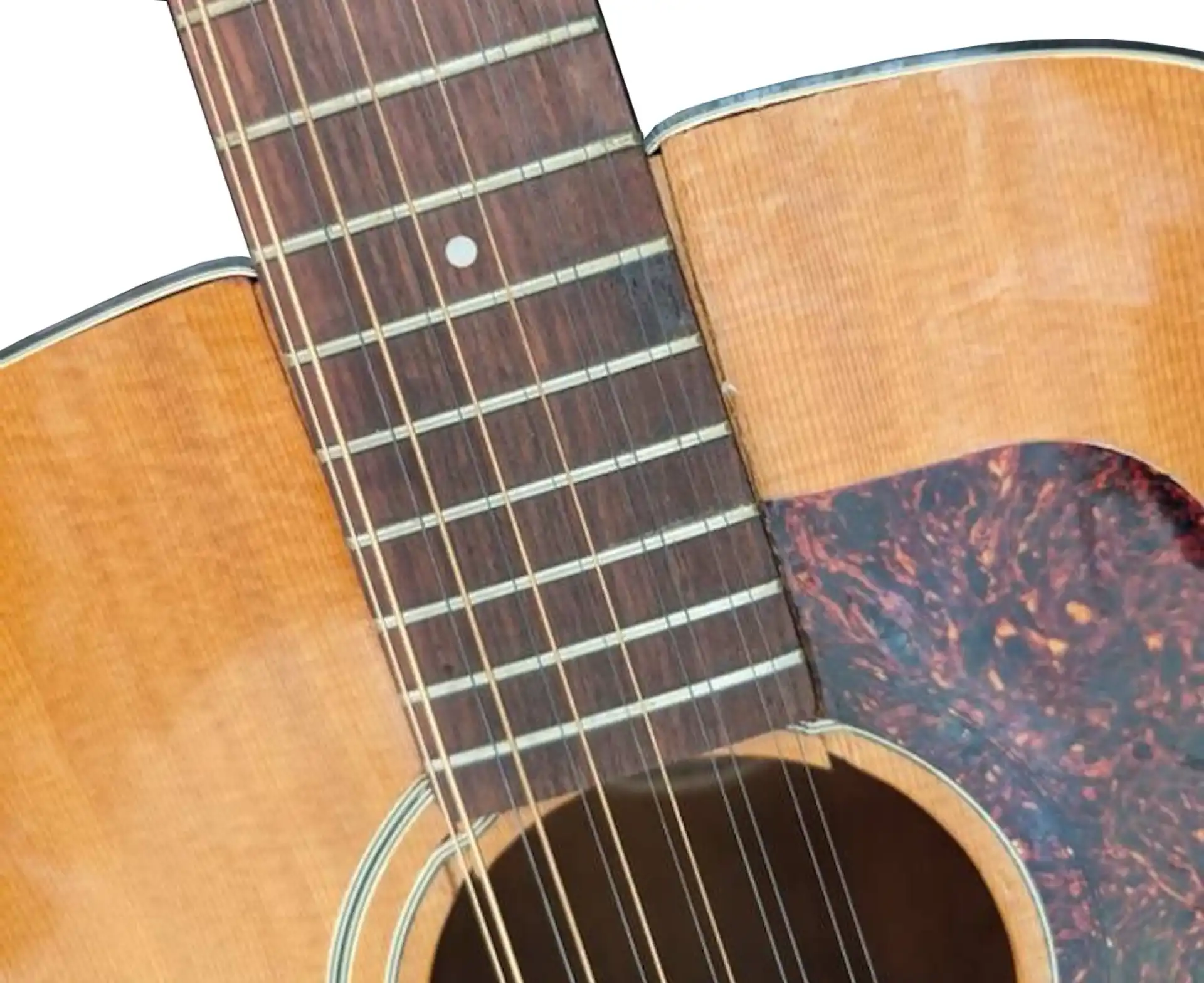
The photo, above, is of a real guitar, a 1996 Guild D25-12 NT. You can read more about it in my article documenting the disassembly and rebuilding of this guitar titled, 1996 Guild D25-12 NT Makeover.
This Neck Block Shift / Soundboard Shear issue is by no means limited to Guild brand guitars, nor is it even restricted to 12 strings. This article is intended to draw attention to what I believe to be an design flaw found in many acoustic guitars.
In my experience, the primary culprit behind the need for a neck reset on an acoustic guitar is the shifting of the neck block (headblock), the worst case scenario resulting in the shearing of the soundboard along the fretboard (fretted fingerboard) extension on one or both sides. Please note that the soundboard does NOT have to split along the fretboard extension for the neck block to have shifted.
I have written an article documenting a neck reset on a Guild 12 string, in which I go into more detail about the topic of neck resets in general, regardless of brand. Rather than repeat all of it again here, you can read my article titled, The Infamous Guild Neck Reset.
In the case of the sudden shift, the entire upper bout, including the neck block and the neck (however it is joined), rotates forward either in response to a sudden change in load or a sudden failure in structural support. I suppose we can all imagine a horrifying scenario where a guitar is hurled out of the window of a high-rise onto the pavement, below. The sudden failure I am referring to may very well be expected to occur as the guitar makes impact. But it also occurs quite frequently in guitars that are not thrown from great heights. If you were to witness this movement, you wouldn't actually see much. If I were to animate an exaggerated version of the event, and play it in slow motion, it would look as though the fretboard extension was dumping a load off into the soundhole. This sudden shift forward is easily responsible for the soundboard shear, that horrific splitting of the soft Spruce soundboard along the fretboard extension, from the binding to the soundhole. Something has to give under the load, as there is NOTHING in front of the fretboard extension except 12.5 square inches of missing soundboard called a soundhole. It is into that void that the neck block, the neck glued into it, and the section of soundboard glued between the fretboard and the neck block shift to... without the rest of the adjacent soundboard!
After the sudden shift, if the soundboard does not split, there is a spring back to the original position, and there may or may not be evidence of the trauma. If there is a split (or two splits, one on either side of the fretboard extension), the neck block/upper bout may appear to have sprung back to its original position, as the tension has been relieved, as is evident from the split. But, in addition to a crack in the wood, there may be a visible mis-alignment at the soundhole, as you can clearly see in the photos, below. Sometimes those splits are not noticeable, not right away, not ever. And sometimes there is such significant forward movement that not only is the soundboard jutting out into the soundhole, but the neck has moved forward into the body, curling the binding in with it. Severe damage, such as you see in the photo of the Martin D-45, below, occurs as a result of sudden, catastrophic failure.
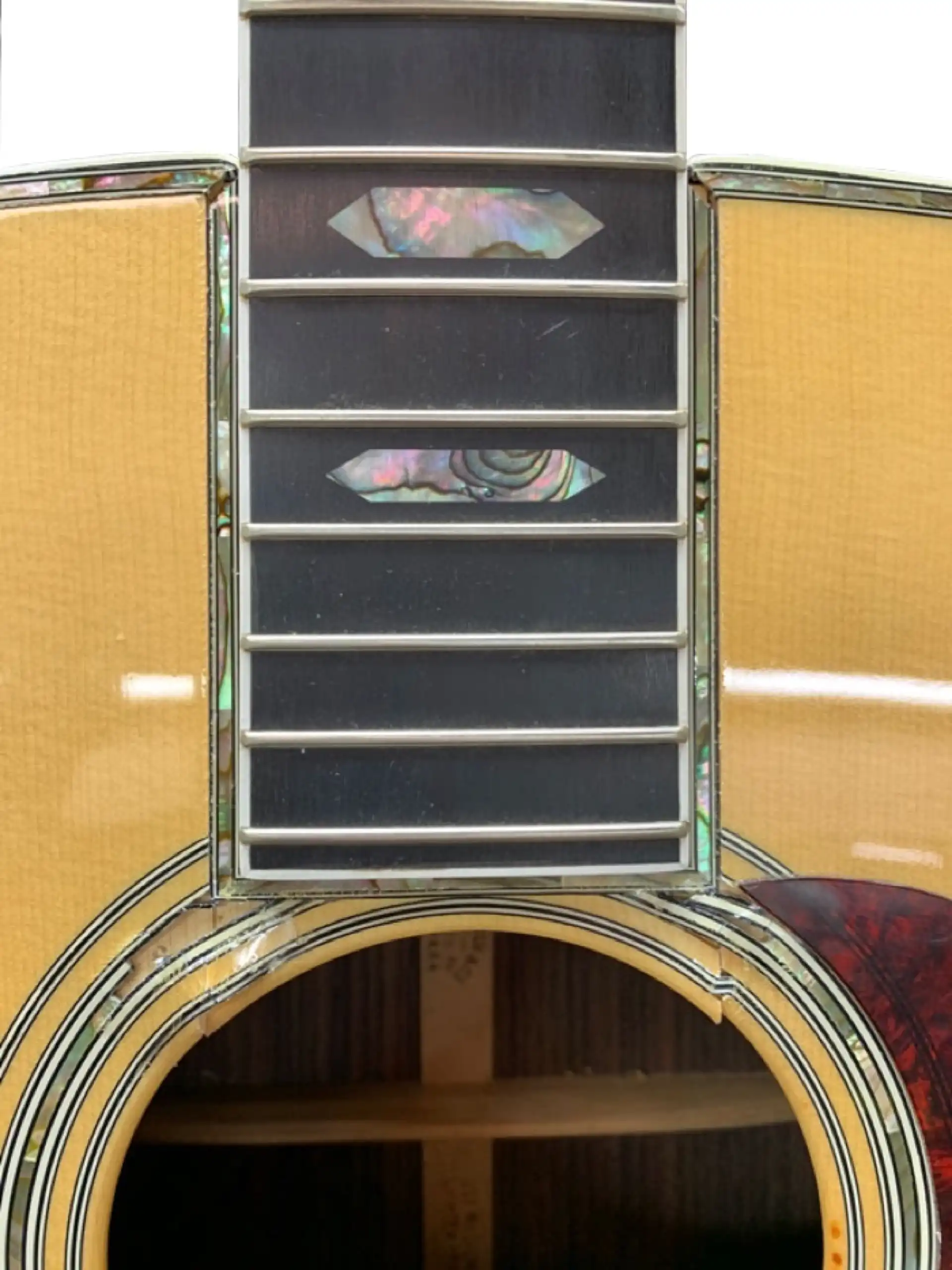
Martin D-45 Neck Block Shift / Soundboard Shear
The other neck block shift is the "slip." This unrequested realignment of components always occurs as the result of glue failure. Glue failure can occur for a number of reasons, perhaps the most common being a combination of temperature issues and string tension, such as when a guitar is left in a hot car. Glue softens and parts slip and slide and shift. Guitars saved from hot cars and left to cool may have all their adjoining pieces of wood continue to be perfectly glued together - and yet those parts have shifted away from their original position(s).
Heat is the primary facilitator of glue failure, but excessive moisture can also cause failure. Rarely, though possible, too little glue may have been applied, and the bond simply fails under load. Whatever the reason for the glue failure, the result is a neck geometry change, a forward-shifted neck. The strings pull the neck and neck block in toward the soundhole. If the glue has been softened, or let's go altogether, the wood pieces move. Depending on what releases first, and how long the guitar is subjected to the conditions that promote the damage, a shearing of the soundboard may or may not accompany the "Slip."
So, which do you think is more likely to be the cause of this Gibson's condition: a gentle relaxing and re-aligning of glue joints or sudden, catastrophic failure?
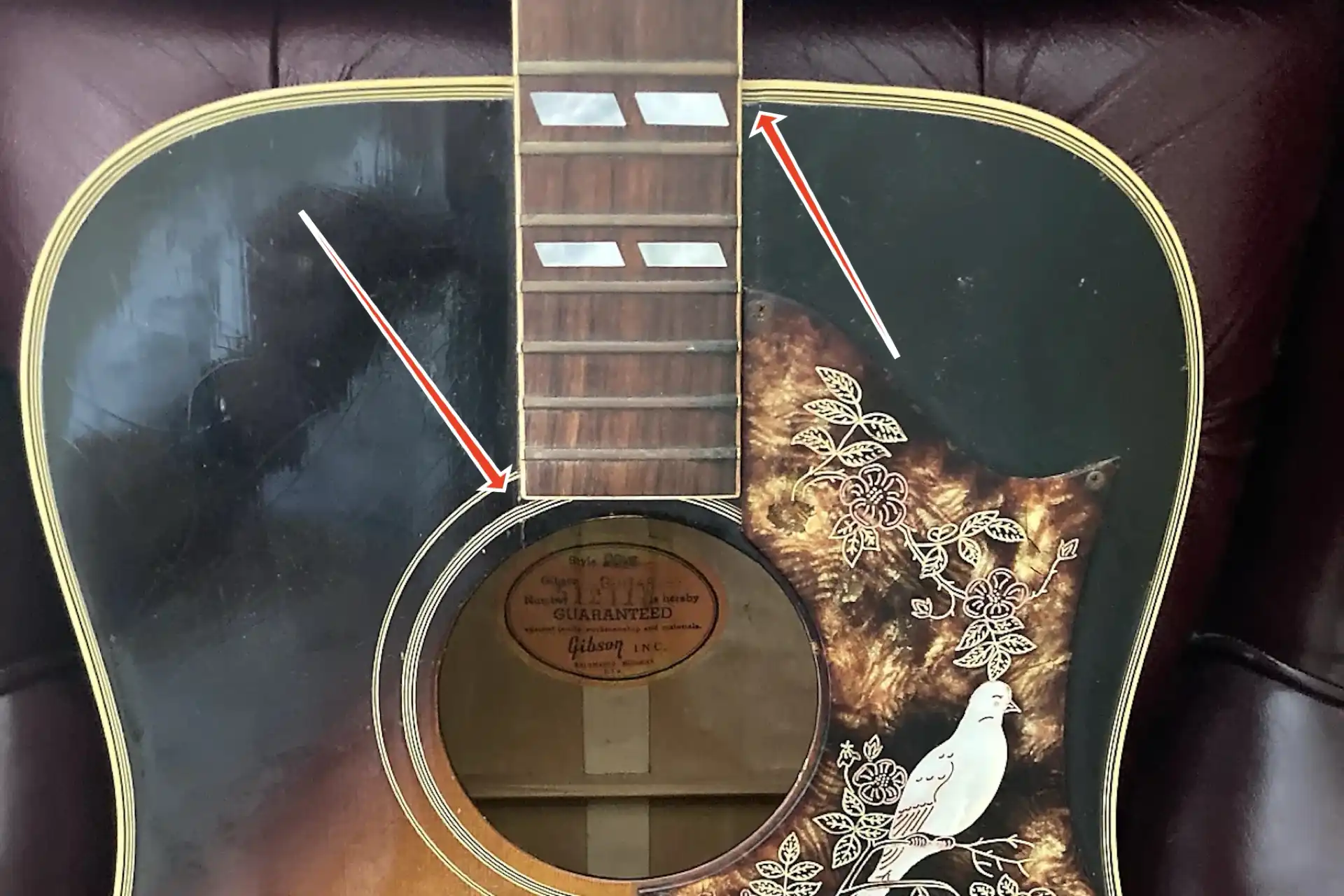
Gibson Dove Neck Block Shift / Soundboard Shear
What if there is no splitting of the soundboard? Does that mean that everything is fine? Look at this next guitar, which does not have any visible splits or cracks along the fretboard extension, at least, not yet. In the first photo, below, look at the stress fractures in the finish emanating from the neck heel/body joint out across each side of the upper bout.
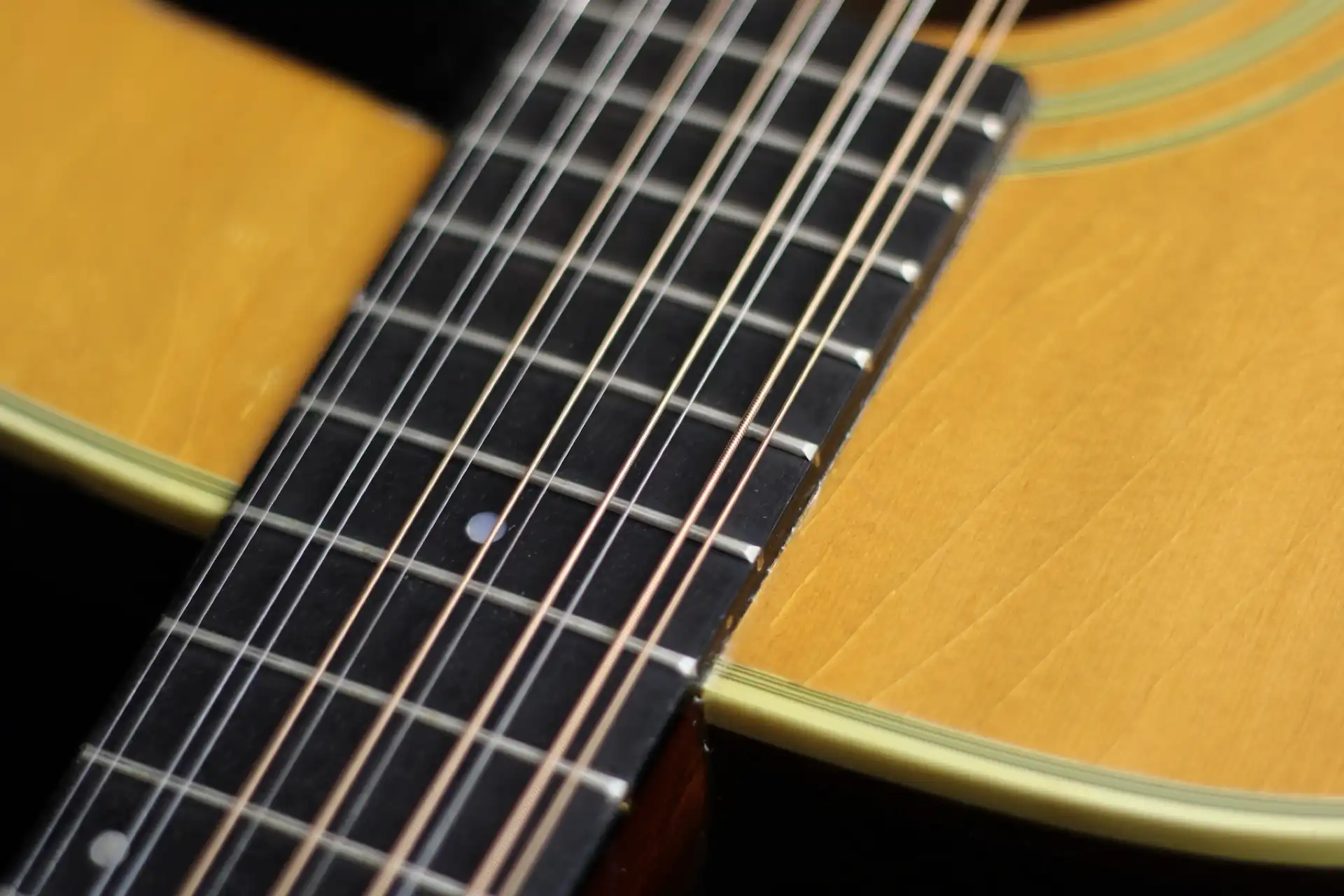
Guild Neck Block Shift / Finish Stress Fractures
Here is a second image of that same guitar. Note the collapsing of the soundboard into the soundhole as a direct result of the forward rotation of the neck and fretboard extension.
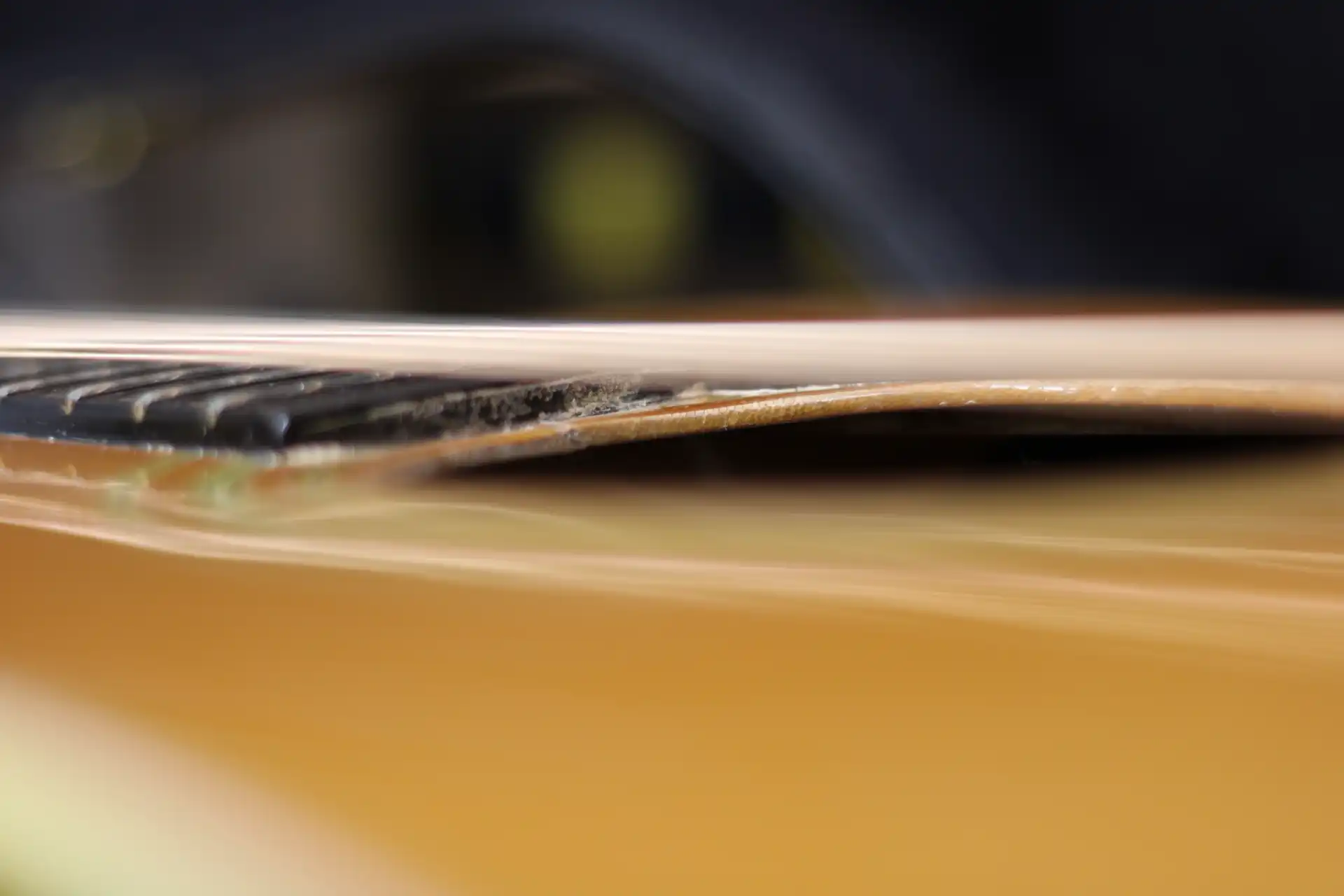
Guild Neck Block Shift / Soundhole Collapse
I have been writing and droning on about this issue for years in the hopes that others will gain an understanding of what I believe to be a common design failure, a mistake that can be corrected, preventing this catastrophic mishap.
There is far too much movement potential in the design of many (most?) acoustic guitar upper bouts. Guilds, Martins, Gibsons and loads of other makes and models have all shared this design flaw at one time or another and are prime targets for this catastrophe. A sudden change, such as a guitar falling over, or being pulled out of a tight-fitting case by grabbing the neck and yanking it free, may be enough force to rotate the neck block forward and split or shear the soundboard. Then again, as we can observe in the photos of the 12 string directly above, a guitar may sit in its case, strung to pitch but undisturbed, for years and a shift can occur. Yes, yes, yes... we are talking about extremely small measurements of movement. But dismiss this movement at your (or your guitar's) peril.
Imagine your reaction if the wheels on your brand of car were to fall off after n-number of miles. I am happy for you if neither you nor anyone else is injured or worse, and thrilled if you have a current Roadside Assistance program and can get back on the road with little interruption to you plans. But, just in case you were never informed, wheels are NOT supposed to fall off! And neck blocks are NOT supposed to shift! And soundboards are NOT supposed to shear!
Countless instruments continue to suffer the fate of a shifting neck block, with and without the oft-accompanying soundboard shear. Why? How did it all get started? Hasn't anyone tried to stop it? Is there anything we can do, or is all hope lost?
Once upon a time, guitars suffered an even more dramatic fate than neck block shift and soundboard shear... It was known as a buckling and collapse! When the first steel string instruments began circulating, replacing their cat gut / nylon string siblings, builders and players alike were able to share in a new experience, where guitars collapsed under the profound string tension. They folded in half upon themselves like a wooden beam snapping under a heavy load.
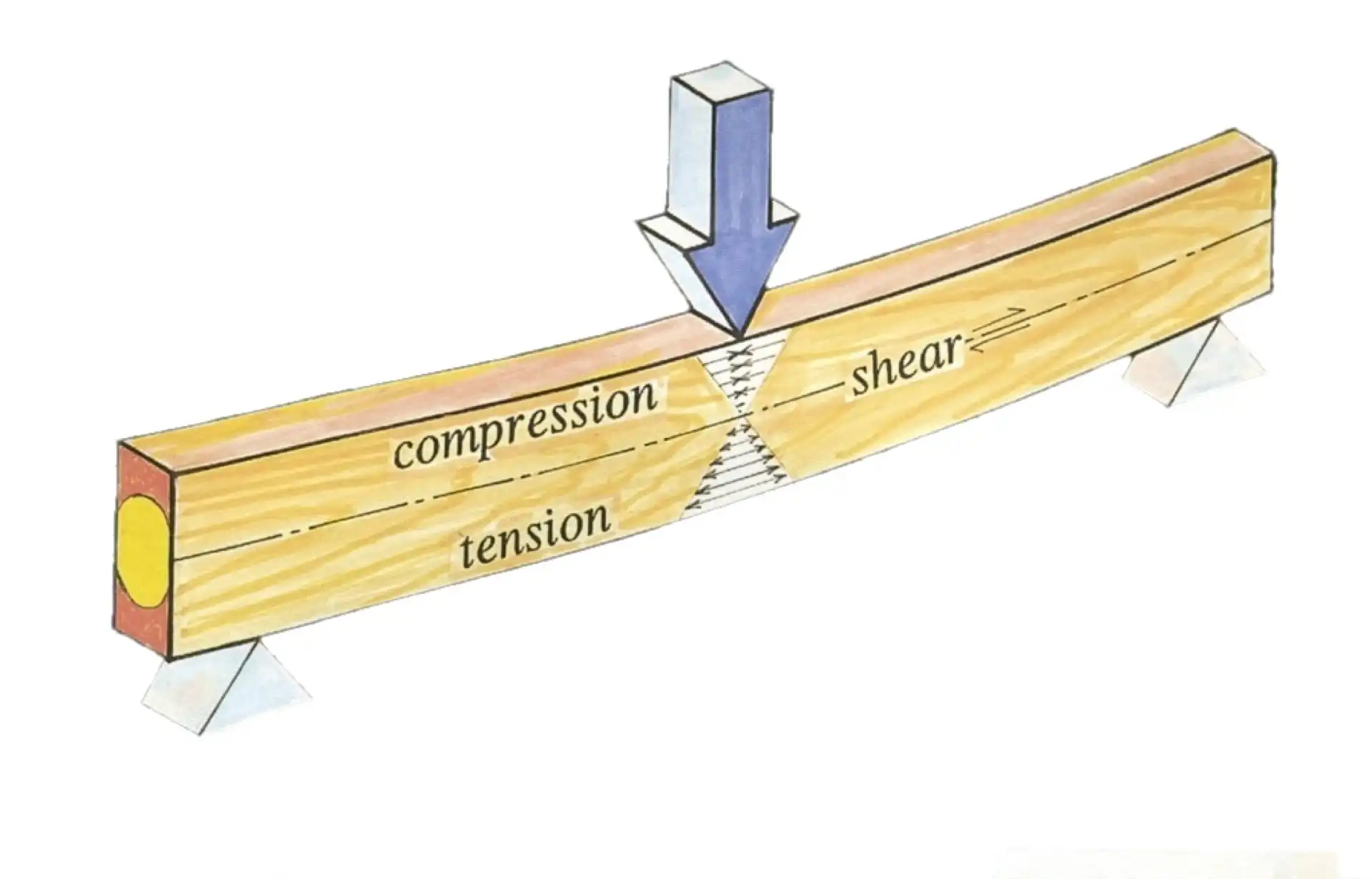
Wooden Beam Buckling
Long, long ago in a shop far, far away, a lone luthier looked down upon the wreckage of an imploded guitar and thought, "Maybe if I glue this monster brace across the upper bout section of the soundboard, that'll fix everything." And the transverse brace (upper face brace) was invented, just like that. At least, that is how I imagine it was invented.
The theory behind the use of the transverse brace that runs from side to side across the upper bout, just above the soundhole, is that the fretboard extension (and the soundboard beneath it) won't plough downward under string tension if supported sufficiently.
But others discovered the transverse brace and incorporated it into their own guitar builds, thinking to themselves, "What a great idea." And it was a great idea, because fewer guitars were completely collapsing and folding in half than ever before. Some even thought, if one transverse brace is good, two has to be better! And the people were happy.
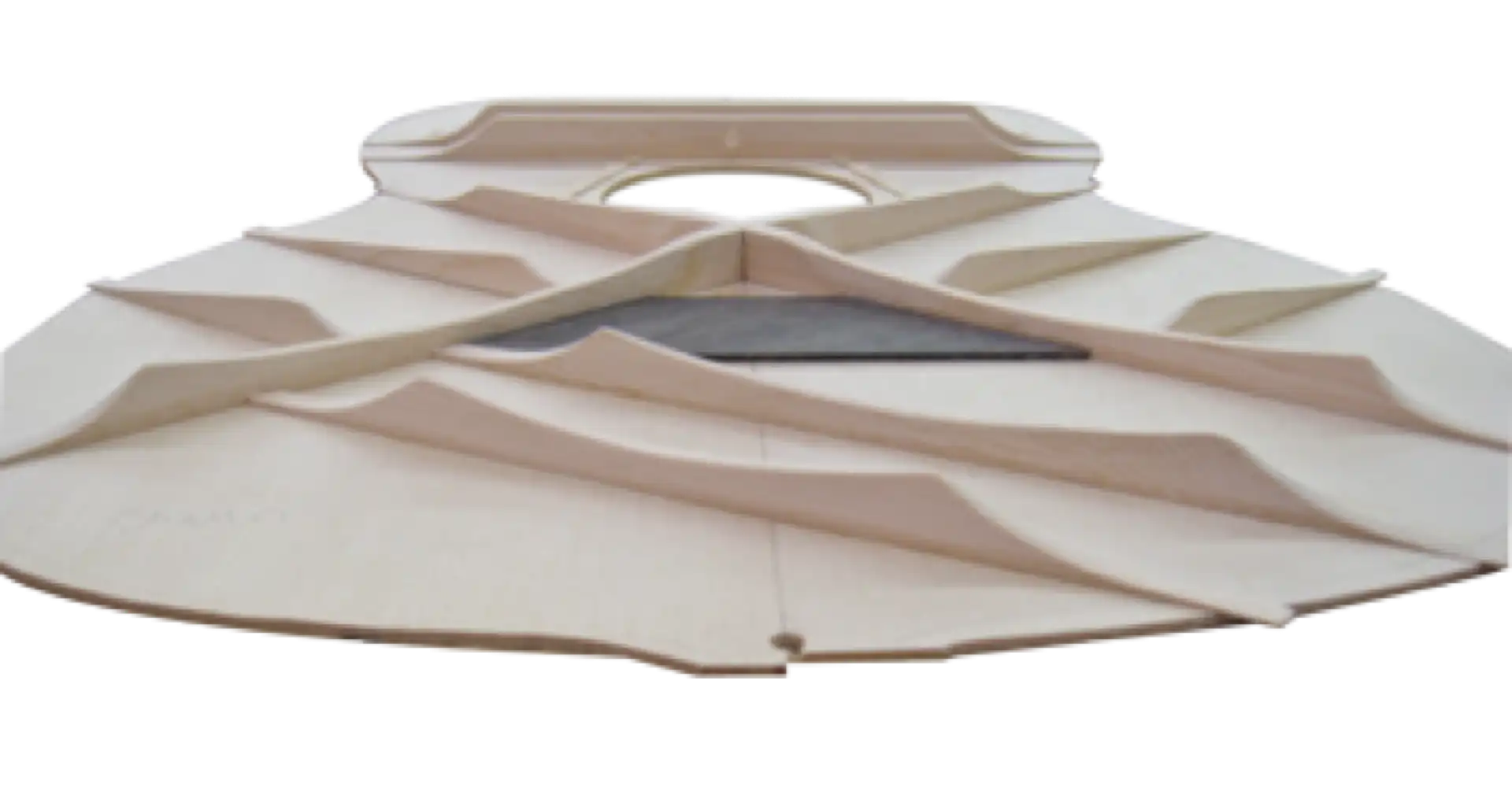
Double Transverse Brace
But the transverse brace didn't stop neck blocks from shifting. And it didn't stop soundboards from shearing.
Less long ago than the first long, long ago, and in a shop a little bit closer than the shop that was far, far away, a lone luthier looked down upon the carnage of a soundboard sheared off deep into the soundhole and thought, "Maybe if I glue this little strip of wood across the upper bout section of the soundboard, in the only space left between the transverse brace and the neck block, that'll fix everything." And the popsicle brace (upper transverse graft) was invented, just like that. At least, that is how I imagine it was invented.
This extra strip of wood is found on 12-fret Martins dating back to the 1850s, and was added to 14-fret Martins around 1939.
And others went and did likewise, thinking to themselves, "What a great idea." And it was a great idea, because... um... because it was fun to say "upper transverse graft," and maybe even more fun later to say, "popsicle brace." More importantly, it didn't stop neck blocks from shifting. And it didn't stop soundboards from shearing. But hey, just be happy your guitar didn't fold in half!
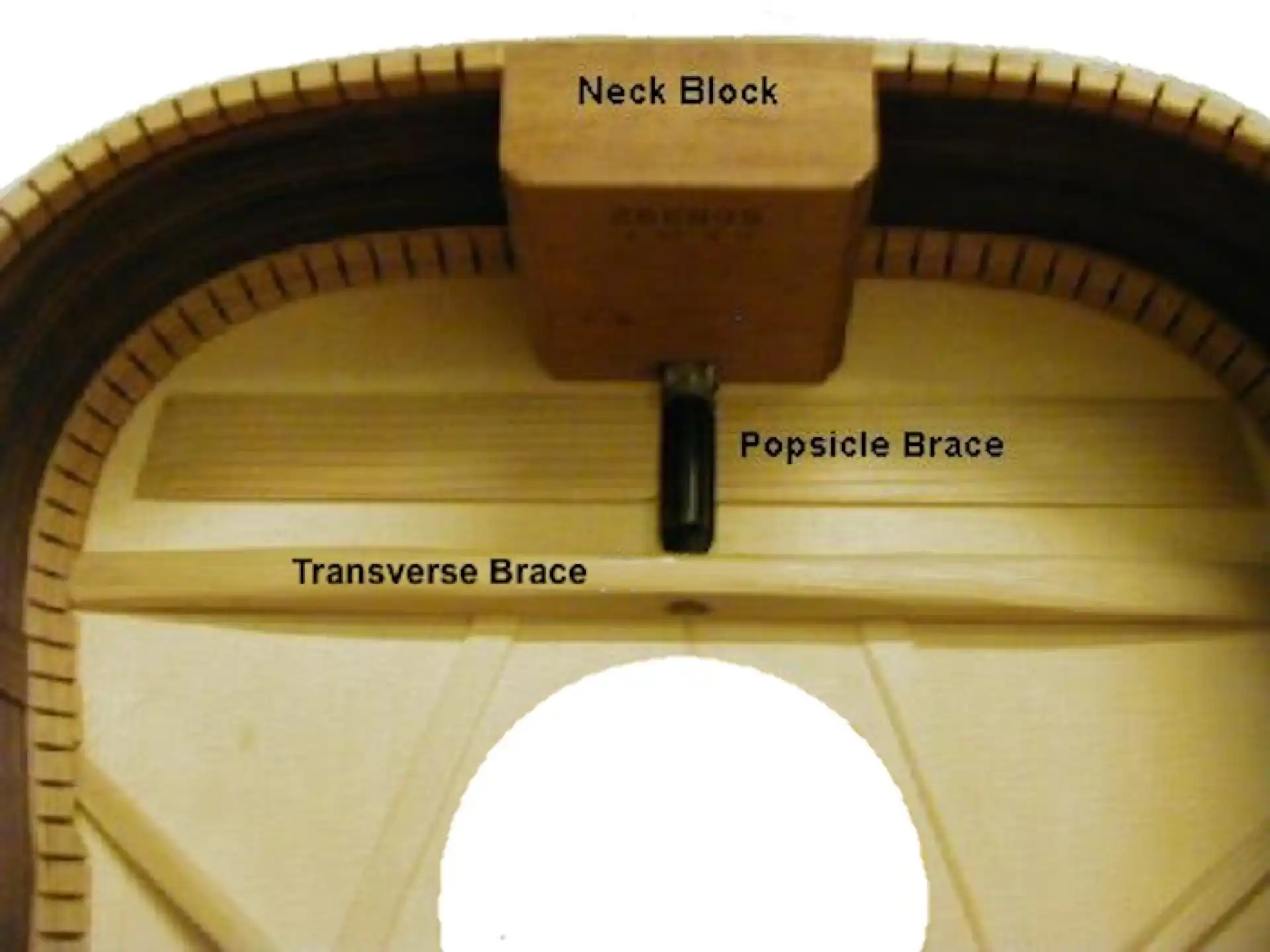
Popsicle Brace
And so guitar makers everywhere added the transverse brace and popsicle brace to their designs and everyone everywhere could now purchase guitars with these innovations. And neck blocks still shifted. And soundboards still sheared. But guitars (mostly) stayed in one piece. And the people were happy.
And a guitar maker here, and a guitar maker there apparently grew concerned about continuing soundboard shear, because strange additional braces began to appear in the upper bout area, the area that once was occupied by only the transverse brace, then was occupied by the transverse brace, with or without the popsicle brace.
Let's Talk Guild forum member GardMan has pointed out that sometime around the Summer of 1974, Guild makers added two "wing" grafts, popsicle-style, to the otherwise unoccupied area of the underside of the soundboard in the upper bout. I call these the "V-Twin" braces. Depending on make and model, these "patches" range in size, from a healthy 3/4" width down to a token 3/8" width. They run diagonally from the transverse brace near the neck block out toward the centers of the shoulders of the upper bout, resembling outstretched arms or wings. It is interesting to note that when a soundboard shear along the fretboard extension occurs in one of these guitars, it always happens between the edges of the fretboard extension and these diagonal brace(s). It seems to me that if sufficient force and/or inertia applied to the neck block/upper bout area were to telegraph along these braces and be concentrated at the soundhole, would this not contribute to a shearing of the soundboard along on or both sides of the fretboard, instead of prevent it? Regardless, the positive contribution of the V-Twins is questionable, at best. But one thing is clear: they are utterly useless at stopping a soundboard shear, as the photo below clearly demonstrates.
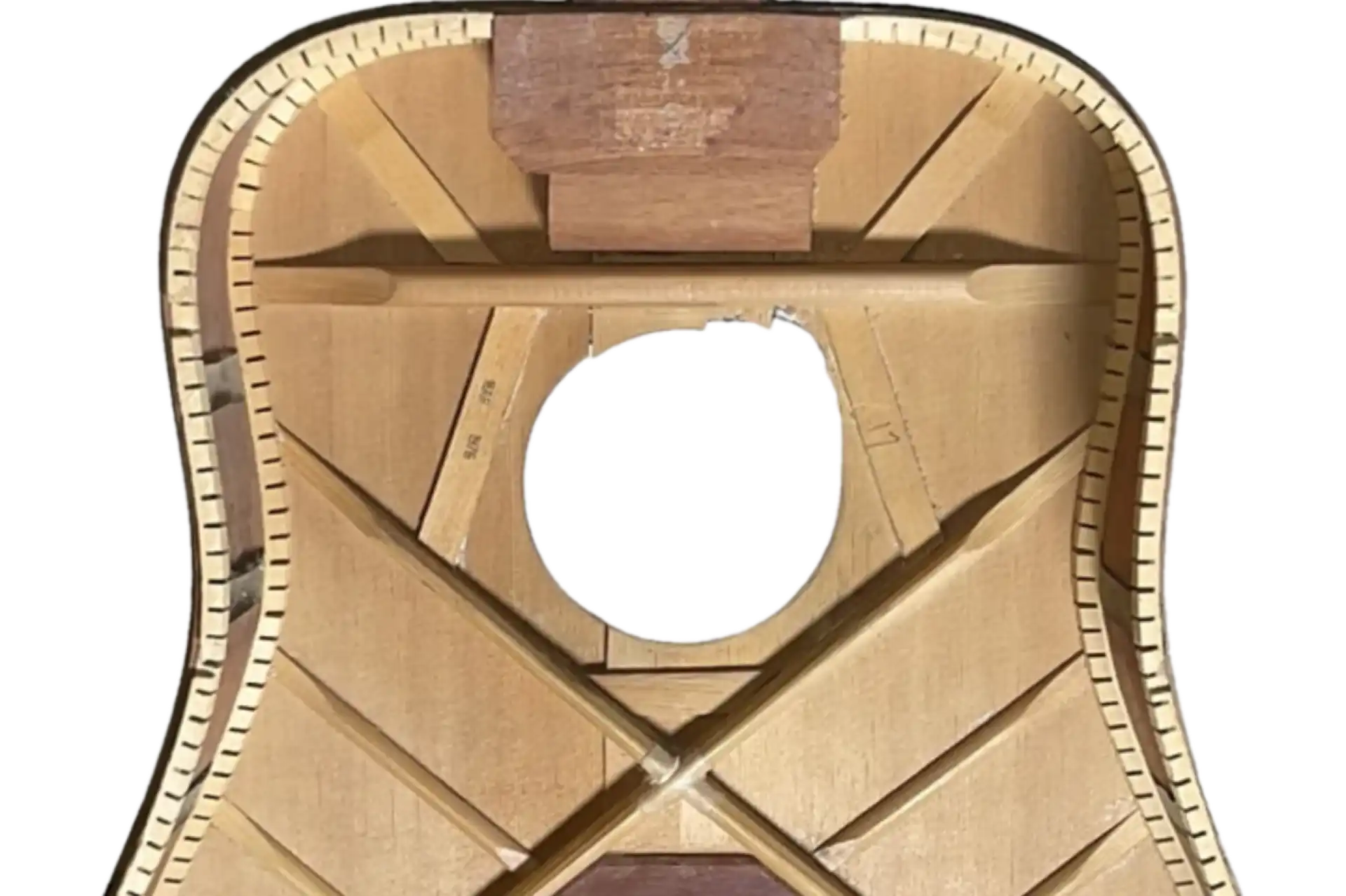
Guild Upper Bout Bracing (1976)
During that same Summer of 1974, and the switch to the V-Twin bracing, a design decision was made at Guild to add a small block of wood to the top front of the neck block, forming a ledge or shelf, purposefully extending the neck block. In theory, this would add more real estate to glue the soundboard to, well above and beyond what you would expect to find in the traditional 6 string guitar neck block. The extra buttressing would potentially aid in resisting the pull of the strings on the headstock and the resultant tendency of the fretboard extension to want to depress the soundboard, pushing it in toward the back of the guitar, as the cantilever of the neck tries to pivot at the body joint, essentially folding the body in half. Sounds good, right?
At whatever point the neck block suddenly shifted and/or tilted forward, it simply took the section of the soundboard that was glued to it along for the ride, shearing away from the adjacent wood of the soundboard. This occurred in spite of all that extra buttressing of the additional ledge added to the neck block, or the support of the transverse brace, or the addition of the "V-Twins" bracing. You may see a theme developing here in my article...
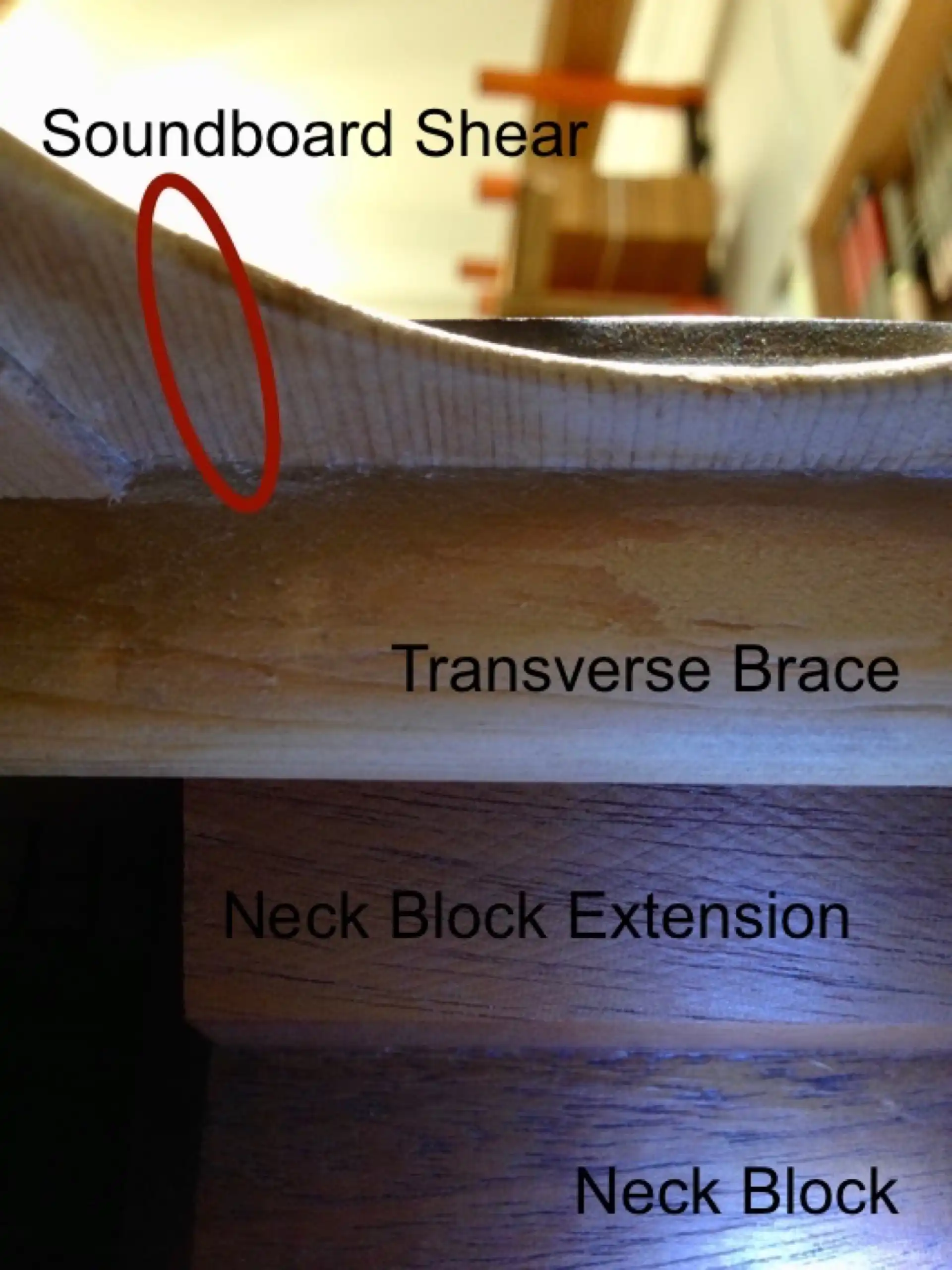
1975 F-212 Neck block
And we must also recognize the Soundhole Support Plate, or "soundhole patch." Many builders decided to replaced the "3 Sticks" soundhole bracing with a thin veneer than sat between the transverse brace and the X-brace. Such an application is certainly warranted if the reasoning is to support the thin soundboard in the area where the giant hole has been cut. This makes even more sense if you understand how much soundboard is removed when large rosettes of shell and plastic or wood purfling are installed. But I do not believe everyone shared the same reasoning behind the initial introduction of the plate. It was thought that this would help to counter the shift and shear issue. Once again, we have an implementation of a design feature based on a false premise, as demonstrated over an over again. Below is a photo of one of these soundboard plates or patches still appearing to be perfectly intact. The only problem here is that the soundboard has sheared clean into the soundhole, as though it completely ignored the presence of the patch.
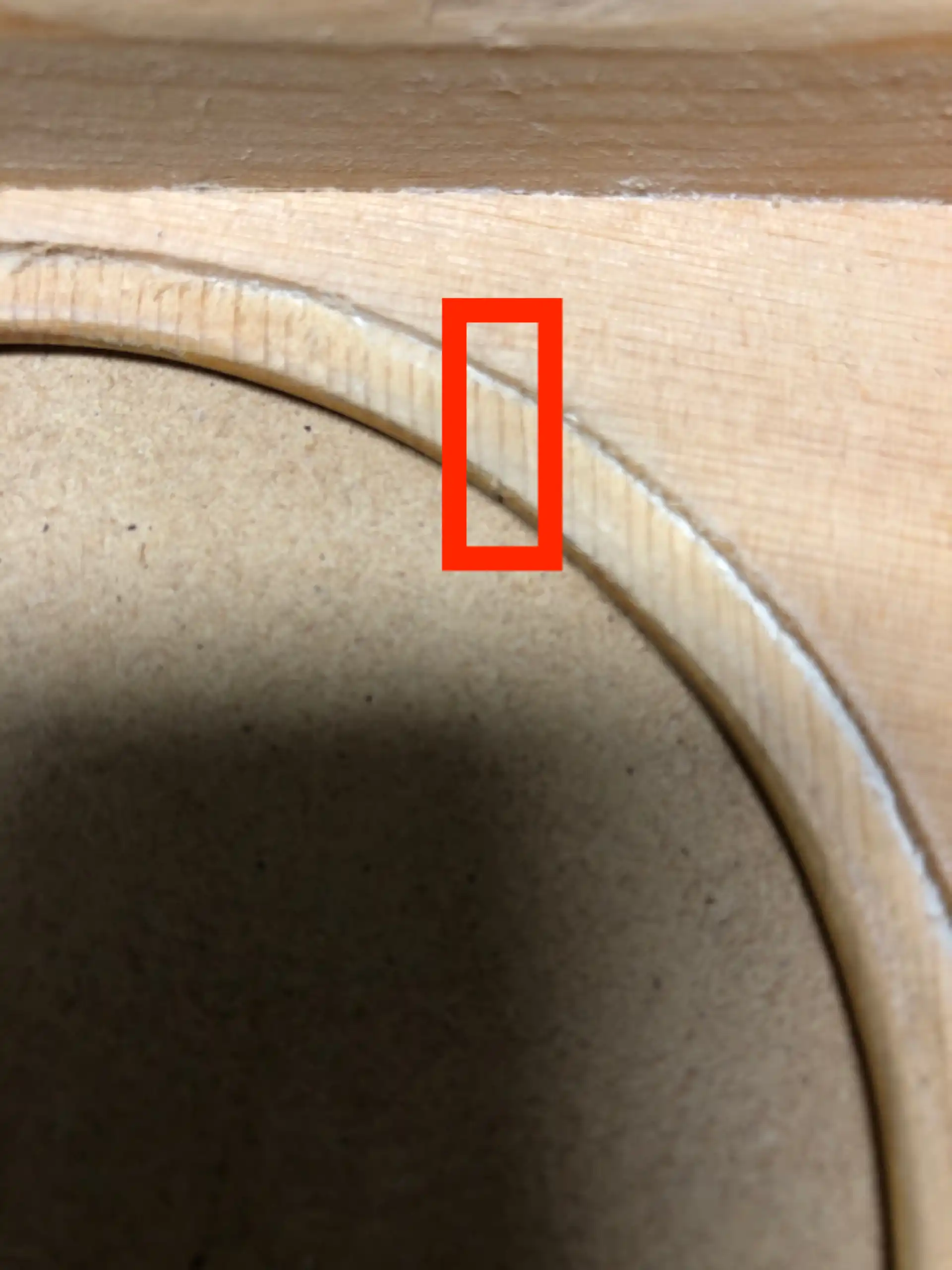
JF65-12 Soundboard Shear
A more recent design that seeks to improve on the popsicle brace/V-Twins braces is seen in the A-Frame brace, where two sticks are glued to the soundboard running between the transverse brace and the neck block. They splay out and across the parallel grain of the soundboard, crossing the point where the fretboard extension lays (on the other side of the soundboard). The idea behind this design could be that the force applied by a shifting neck block would be distributed to the outside(s) of the soundhole...?
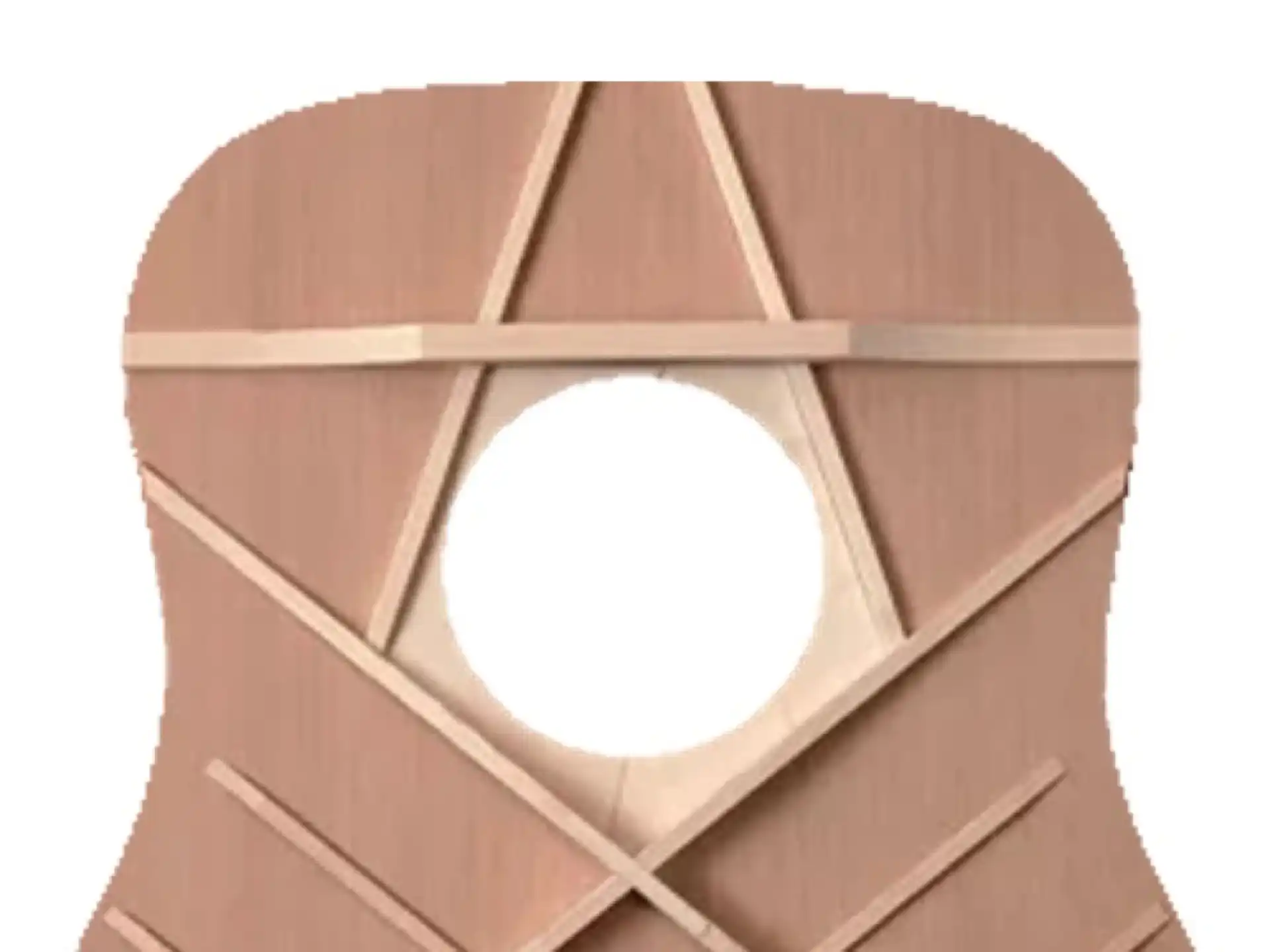
Trapezoidal Brace
All of these attempts at mitigation have proven to be ineffective. Let's look just a bit deeper into the force(s) at work behind the shearing of the soundboard.
Traditionally, acoustic guitar fretboards have been made from very dense hardwoods, such as Ebony and Rosewood. The grain direction of the fretboard runs lengthwise from the headstock, down the neck and out onto the soundboard. It will expand and contract from side-to-side when exposed to moisture variations. Traditionally, the fretboard extension is glued down to the soft Spruce soundboard beneath it. The grain direction of the soundboard also runs lengthwise, and it will also expand and contract from side-to-side when exposed to moisture variations. The soundboard is glued down to the neck block.
The neck block's grain direction is perpendicular (rotated 90°) to the soundboard and fretboard. Traditionally, the neck block is positioned in such a way as to expand and contract in the same direction of the sides, up and down. Of course, wood moves in more than just one direction. In this photo I have drawn a double-headed arrow indicating the direction the neck block will expand and contract due to moisture variations. Let your imagination be your guide, and consider what may occur should the moisture content change... fretboard and soundboard trying to move along one path, though at different measurements of movement, and the neck block trying to move along a path that is perfectly 90° to the grain direction of the soundboard. It don't take much!
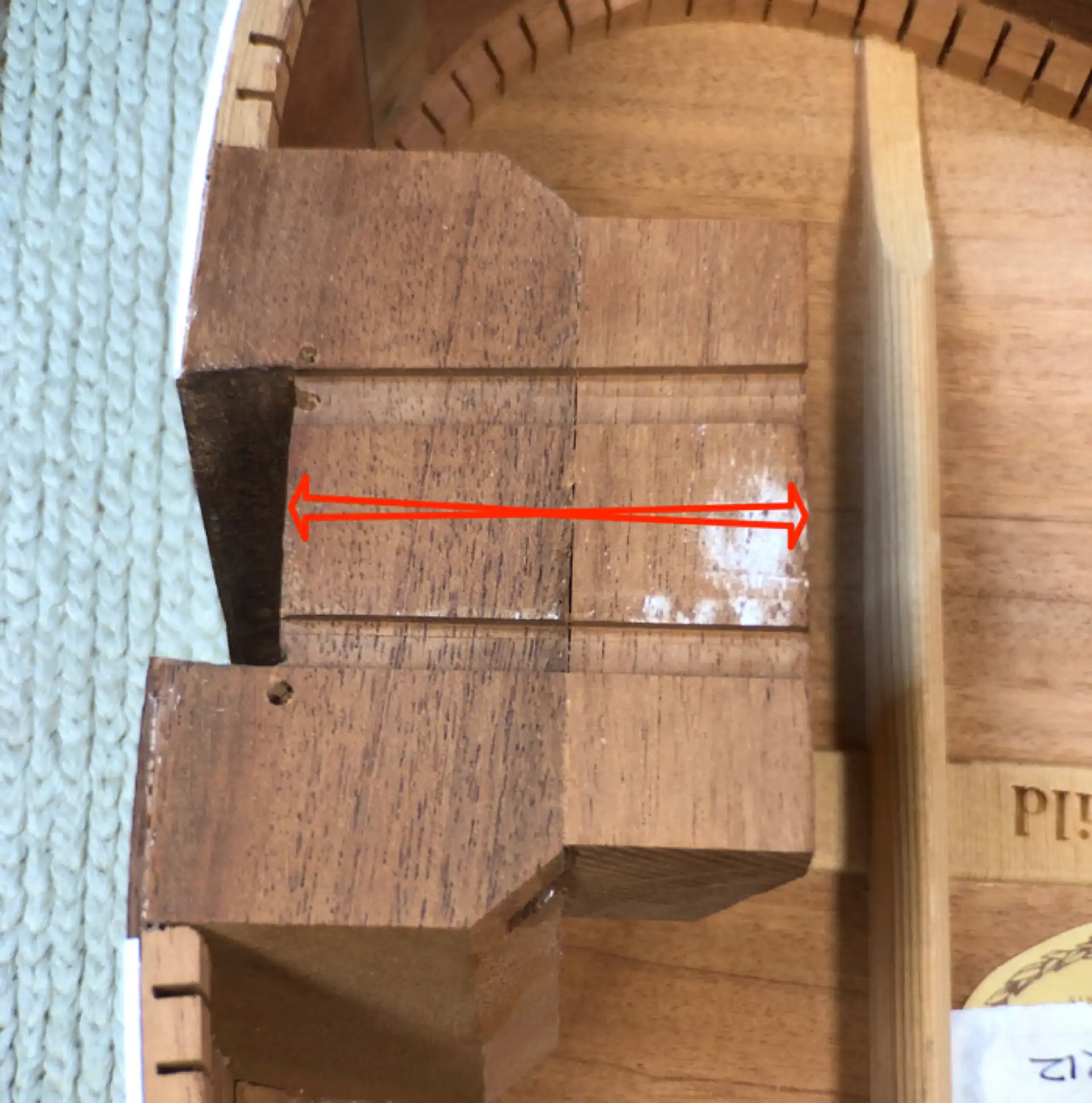
Neck Block Grain Direction
There is a place in the life of the struggling musician (or any entrepreneur) where budget constraints dictate... well, everything. There are those of us who may desire more than we currently have, but we can't always have all that we desire. C'est la vie! If I could make a suggestion, however: Resist the temptation to justify legitimate structural damage to your guitar, damage such as a soundboard shear, by referring to it as 'Mojo.'
When a stress crack appears in the foundation of a high-rise, it is not referred to as "Mojo." When a stress fracture appears in the engine mount of an aircraft, it is not referred to as "Mojo." When a crack runs across the windshield of your car, you don't call it "Mojo" (well, some of you might, but you shouldn't). The shearing of an acoustic guitar's soundboard is called "Damage," not "Mojo."
To repair damage to a foundation, it usually involves more than a little glue, as does the repair of an engine mount, or a cracked windshield. Not wanting to spend the money to effect such a costly repair is perfectly understandable, and drives so many decisions we are all witness to. Who would ever want to spend money, voluntarily, if they could just ignore the problem? It is not as though lives are depending on the structural integrity of my acoustic guitar!
But, like it or not, my guitar is structurally damaged. My choices now are fairly straightforward: I can choose to do nothing about it, and live with the damage. I can spend money to repair it (or attempt to repair it). Or I can start fresh with another (undamaged) instrument.
To better understand what is causing or allowing for our neck block shift and soundboard shear, we can look to the soundhole. To put things in perspective: when tightened, guitar strings are quite capable of ripping the bridge off the face of the guitar. A 4 inch diameter hole has been cut into a thin wooden plate in front of that bridge, in a location that, in the case of a 12 string guitar, is supporting well over 200 lbs of pressure/tension.
The neck is a cantilever. It is affixed to the body at the upper bout. On many (most?) acoustic guitars the neck joint can act as something of a hinge, allowing the neck/neck block/entire upper bout (as a unit) to tilt or pivot forward. This action will result in the concentration of force onto the precise location of the soundboard where 12-1/2 square inches of very needful support material is now non-existent. What could possibly go wrong? The fact that soundboards having no soundholes (or significantly offset soundholes) do *not* experience shearing along the fretboard extension is clear evidence of the actual problem.
I believe that most of the steps taken to mitigate the neck block shift have focused on the hinge aspect of the cantilever neck that I mentioned earlier. It is assumed that the neck is hinging at the neck/body joint, and therefore the fretboard extension must be supported by the massive transverse brace, else the neck will fold forward. And yet, neck blocks still shift forward, and soundboards still shear along the fretboard extension.
 Neck Pivot
Neck Pivot
A body of evidence has piled up around us over the decades, evidence that clearly demonstrates the design of the support of the upper bout of most acoustic guitars is flawed. The force that is responsible for the neck block shift and soundboard shear is not the hinging motion. I think I have used the word "forward" ten times in this article up to this point. That might provide you with a clue as to where I am headed...
Instead of insisting that the neck is pivoting at the edge of the body, understand that the neck is attempting to plunge forward into the body of the guitar. Very little, if any attention has been paid to this fact, as builders everywhere jumped on the hinging motion bandwagon and never looked back. Me included. The first couple of guitars I ever built had transverse braces and fretboard patches. I lacked the understanding to see how, by just emulating yesterday's designs, I was doing nothing to resist this forward shifting potential.
 Neck Movement Direction
Neck Movement Direction
Stop the shift before it starts. An ounce of prevention is worth a pound of cure.
Mitigation efforts have consistently failed due to the assumption that the force to be countered is downward. By the time the downward movement is occurring, or even about to occur, the damage is already done! The neck has already shifted in toward the body and it is too late to do anything about it. By understanding that the force to be countered is forward, one can realize the folly of adding more cross-bracing in the upper bout and begin to explore the design changes necessary to stop the shift before it starts. An ounce of prevention is worth a pound of cure. If we prevent the neck from moving forward, it CANNOT hinge downward. If we prevent the neck block from shifting forward, the soundboard does not shear. And if we prevent any forward movement on the part of the neck / neck block / upper bout, we do not need to reset the neck... (unless there is a problem with the bridge/bracing, but that is an entirely separate issue).
To better support a center soundhole design, especially on a 12 string, it is necessary to reinforce the upper bout. It must be fixed in place to become immoveable. My approach focuses on unifying the soundboard above the waist, the back, the neck block, and the sides into one immovable (or nearly immovable) mass. No more neck block shifts. No more soundboard shears/splits along the fretboard extension. No more neck resets as a result of either of the two aforementioned issues.
The problem:
 Sinkhole
Sinkhole
Whenever I build a center-soundhole-X-braced soundboard, I remove what would otherwise be the structural support necessary to resist the forward movement potential of the neck / neck block into the body. I MUST do something to restore that support, or I will continue to suffer neck block shifting and soundboard shearing.
I have altered the build design of my center-soundhole-X-braced acoustic guitars to eliminate forward movement of the neck into the body by altering three three aspects of traditional design:
I have found that laminating two hardwood Mahogany veneers to the underside of the softwood soundboard is sufficient to support anything I can throw at this guitar, I am careful to ensure that none of my straight-grained layers are parallel.
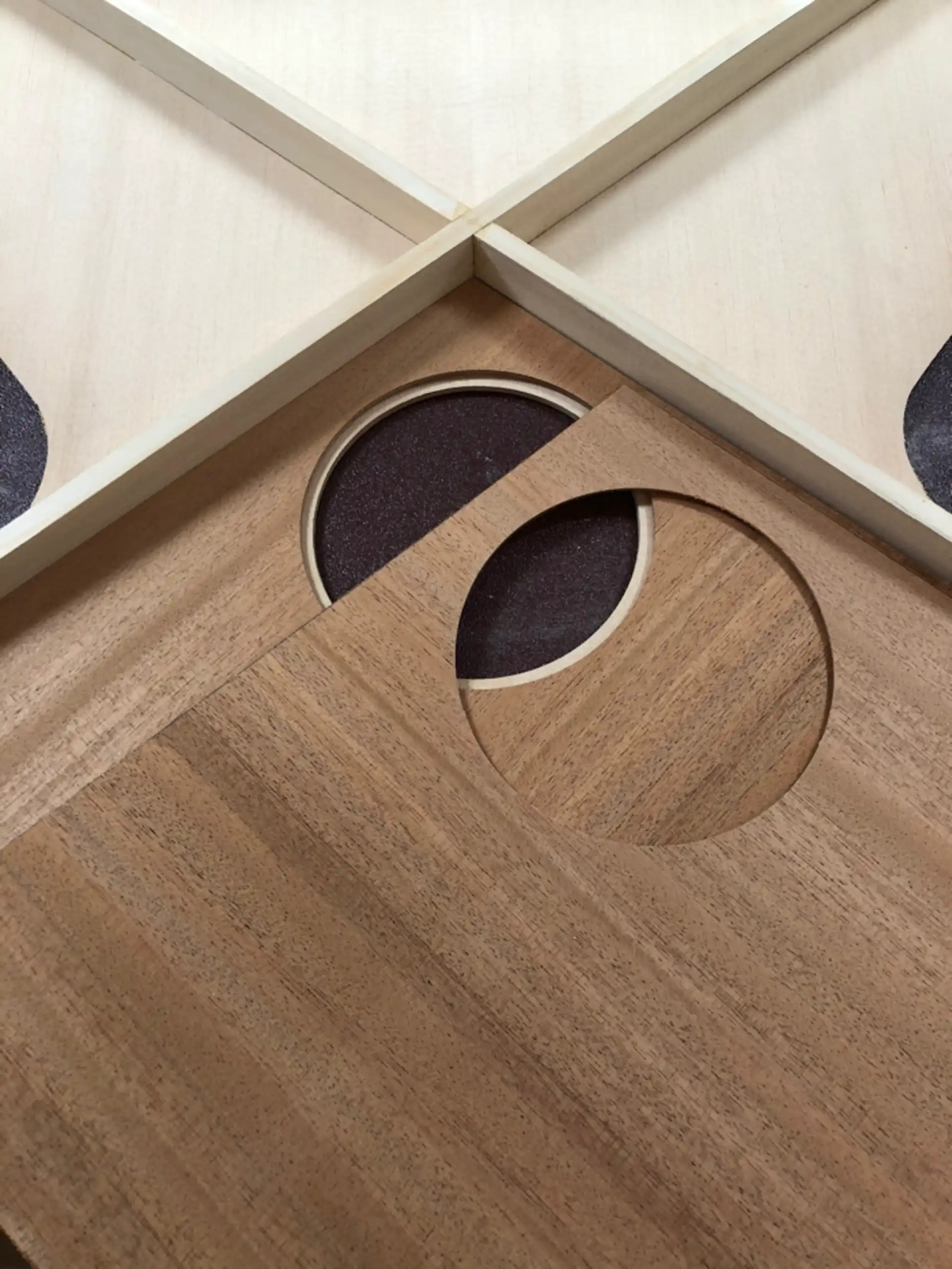 Reinforced Upper Bout - Traditional Soundhole
Reinforced Upper Bout - Traditional Soundhole
For the soundboard in the photo, above, I have set the laminated support back from the rim of the soundhole, giving the guitar a more traditional appearance when viewed from the front. Here is another reinforced soundboard in which I have bound the soundhole.
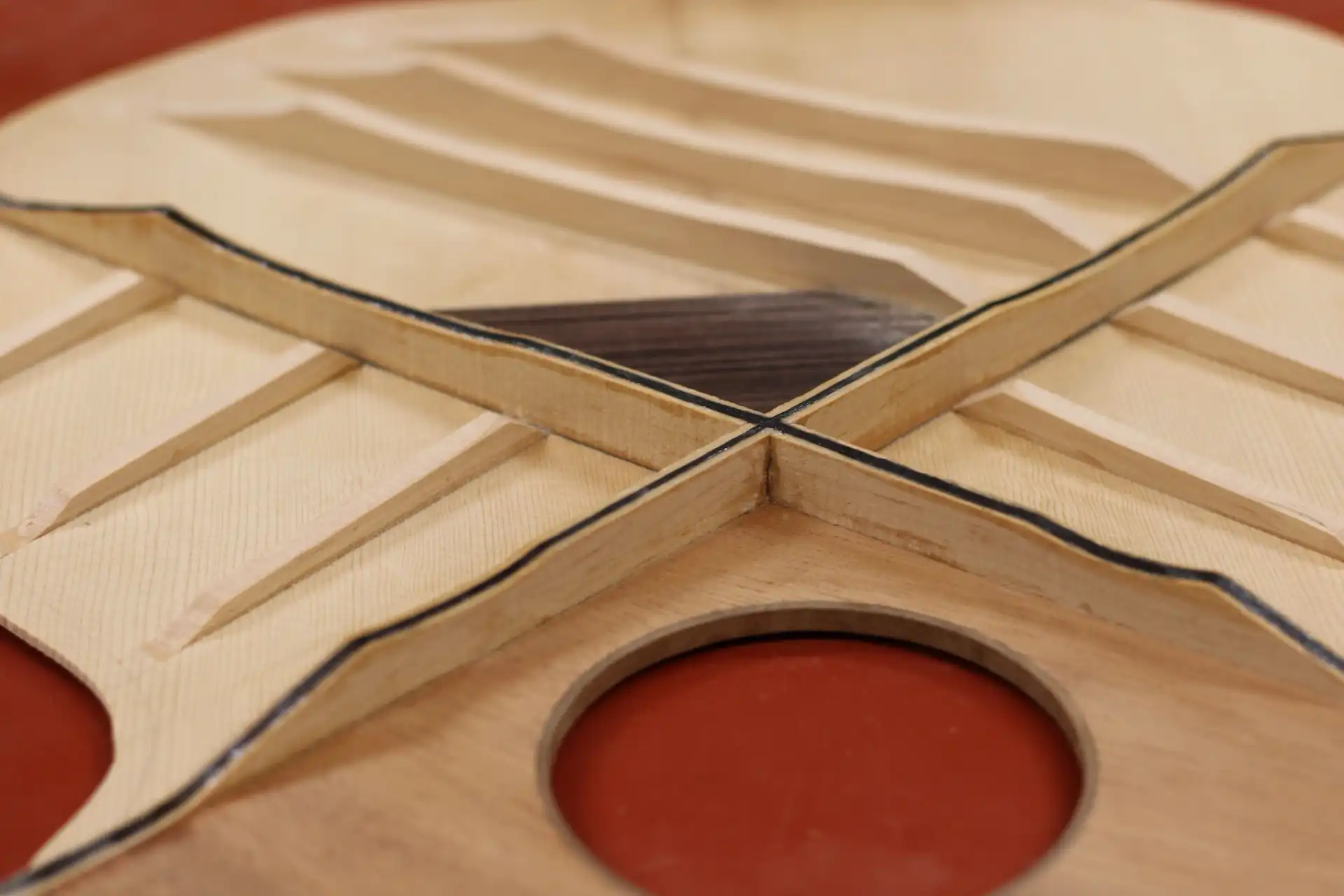 Reinforced Upper Bout - Bound Soundhole
Reinforced Upper Bout - Bound Soundhole
Once my new soundboard is complete and ready to install, I "lock" that reinforced, laminated section into place. Instead of simply notching the sides (rims) to receive the upper arms of the X-brace, I "let in" the entire upper bout to the body by lowering (terracing) the sides from X-brace arm, around the upper bout and across the neck block, to X-Brace arm.
Knowing that heat plays a role and is a factor in many neck block shift scenarios, I attach this new soundboard using an adhesive that is both non-creeping and heat resistant: epoxy.
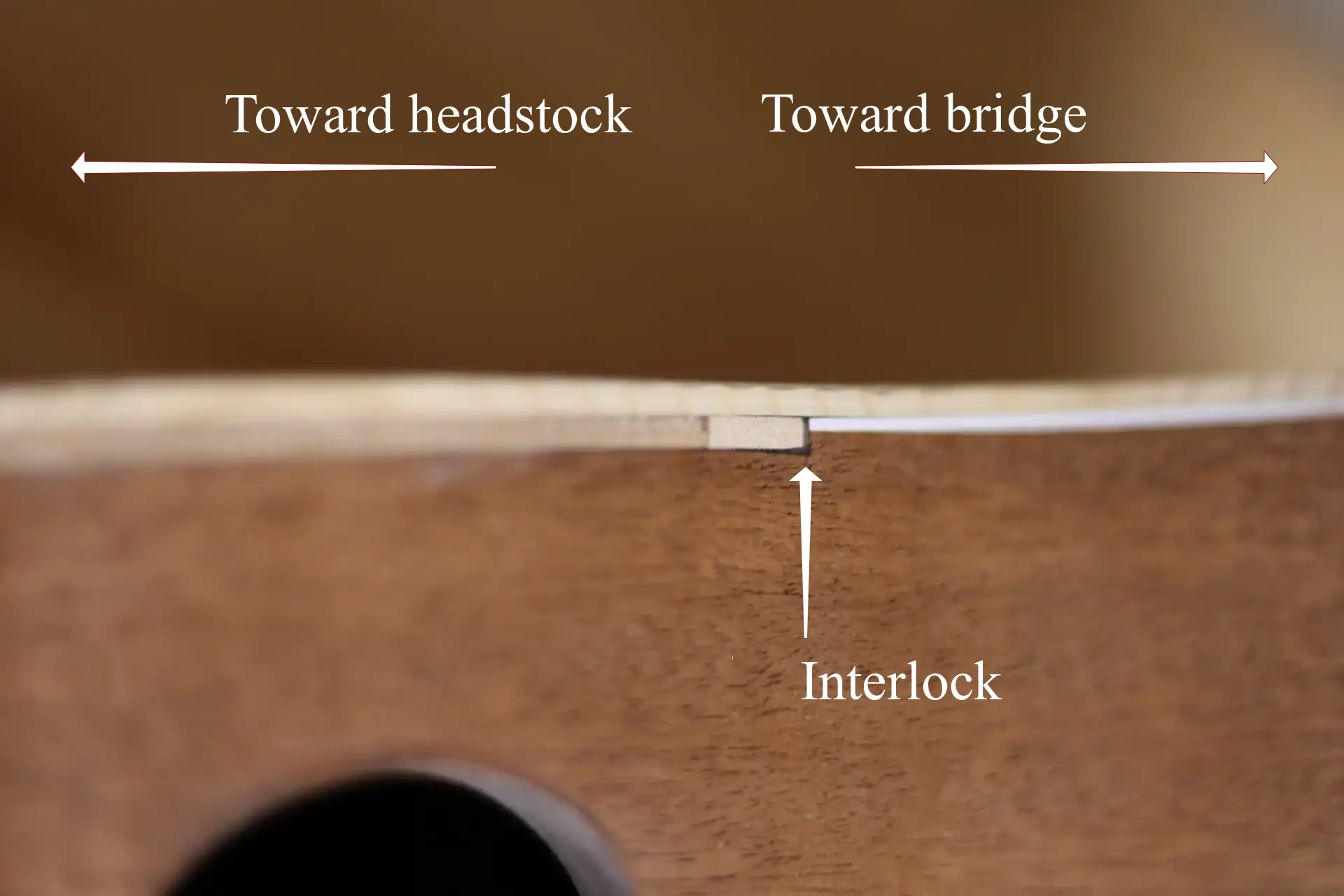 Soundboard Locked to Sides
Soundboard Locked to Sides
If you are concerned about the added weight of the lamination, don't be. I have eliminated the transverse brace, fretboard patch, V-Twins bracing, and any other useless addition of wood to the upper bout. With a 2-layer wood lamination (three layers total, including the soundboard), the total weight ends up identical to what it would have been with a traditional design. It is even lighter when I replace the two layers of Mahogany with a quasi-isotropic carbon fiber plate. Remember, in addition to losing the extraneous upper bout bracing, I also remove material from the sides, kerfing, and neck block (to lock the upper bout in place. The guitar ends up a bit lighter than one built traditionally.
Since altering my own designs and my approach to addressing this issue, I have become aware of others utilizing carbon fiber rods in an attempt to stabilize the neck block. Here is a photo of the bracing style developed by luthier Rick Turner for his Compass Rose acoustic guitars (thanks to kostask at Let's Talk Guild forum!). Turner's approach attempts to brace the neck block against the tail block via the waist. A pair of rods run from each side of the neck block to the waist. Two additional rods, one on each side, run from the waist to the tailblock. Six rods in total are used to try to stabilize the neck block.
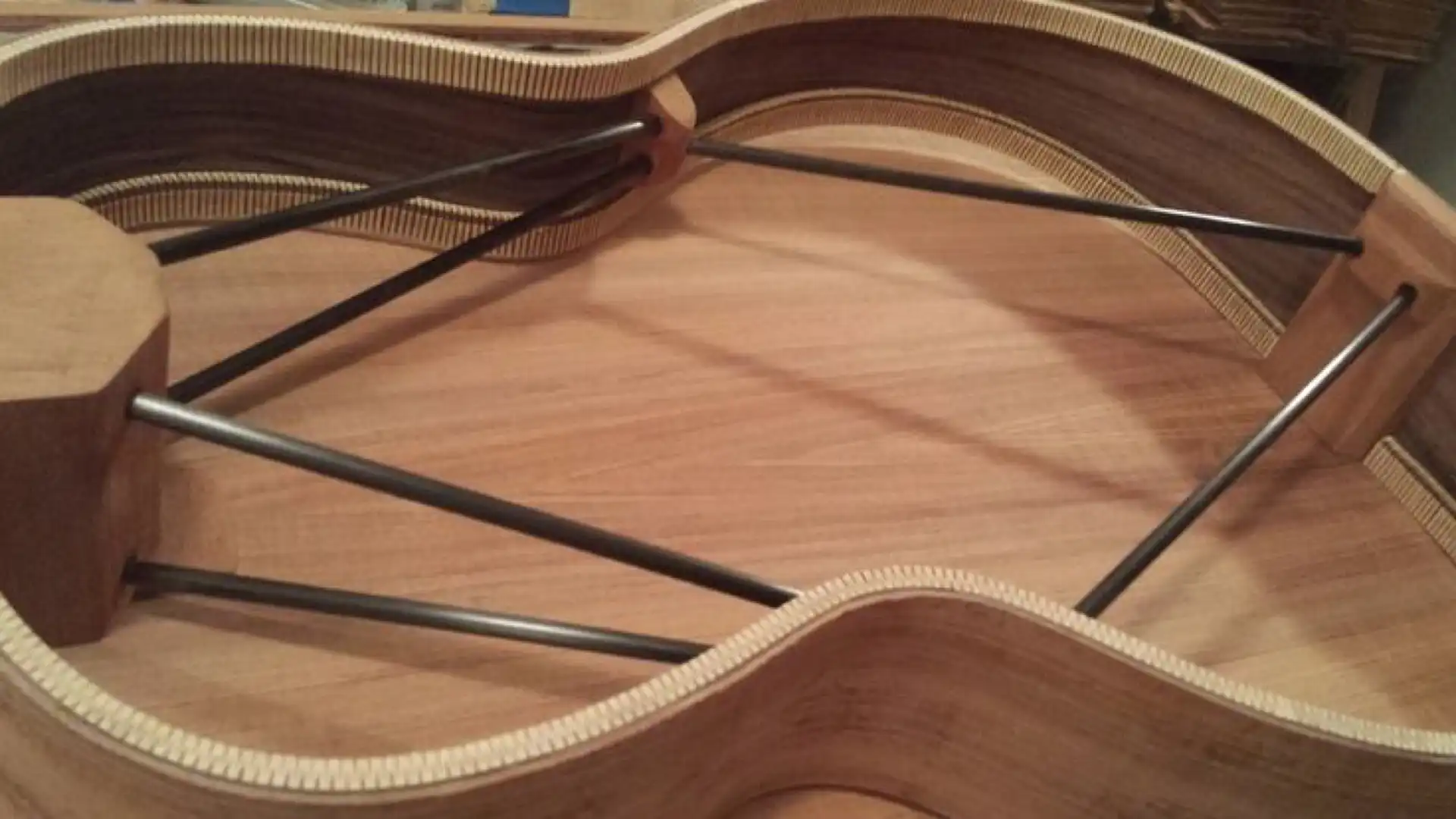 Rod Braced Blocks
Rod Braced Blocks
I applaud any and every attempt to immobilize the upper bout of the acoustic guitar. The structure that supports the soundboard must be rigid. By eliminating the potential for movement of that structure, failure of that supporting structure due to the pull of the strings can be completely prevented.